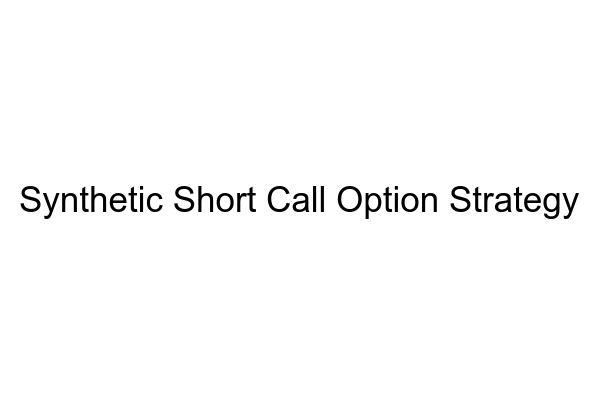Synthetic Short Call Option Strategy

What are the characteristics of this option strategy?
The Synthetic Short Call Option Strategy is an options trading strategy involves selling a put option and shorting a stock. This strategy enables investors to better manage risk while potentially making a net gain when the stock moves in a neutral direction. The strategy also involves investors creating a hypothetical option position with the same payoff as the original short call position, while reducing the financial risk associated with it.
Is this a bullish, bearish or neutral strategy?
The Synthetic Short Call Option Strategy is a neutral strategy. It works in any market condition and is suitable for investors who wish to manage their risk exposure.
Is this a beginner or an advanced option strategy?
The Synthetic Short Call Option Strategy is considered an advanced option strategy. It involves sophisticated theoretical concepts and advanced investment techniques. Therefore, investors should understand the basics of options trading before attempting to implement this strategy.
In what situation will I use this strategy?
The Synthetic Short Call Option Strategy is typically used when investors believe that the stock price will remain relatively unchanged. In this situation, the investor would sell put option and short stockin order to reduce their risk while potentially generating a net profit.
Where does this strategy typically fall in the range of risk-reward and probability of profit?
The Synthetic Short Call Option Strategy typically falls somewhere in the middle of the risk-reward and probability of profit range. The strategy carries a higher risk than strategies involving simply buying or selling a call option, but it also has the potential to generate a larger reward than those strategies due to the protective component of the put option.
How is this strategy affected by the greeks?
Since the Synthetic Short Call Option Strategy involves both – shorting stock and put option, the strategy is affected by all of the four greeks – delta, gamma, vega, and theta. Delta measures the effect of the underlying stock price on the option position, gamma measures the rate of change of delta with respect to the underlying stock price, vega measures the sensitivity of the option price to volatility, and theta measures the time decay of the option position.
In what volatility regime (i.e VIX level) would this strategy be optimal?
The Synthetic Short Call Option Strategy is typically most effective when the VIX level is high. When volatility is high, the risk associated with buying a call option is also high. By investing in a Synthetic Short Call Option Strategy, investors are able to reduce their risk while potentially generating a net profit in a High VIX market.
How do I adjust this strategy when the trade goes against me? And how easy or difficult is this strategy to adjust?
Adjusting the Synthetic Short Call Option Strategy when the trade moves against you can be easy or difficult, depending on the specific parameters of the position. The easiest way to adjust the position is to close it out and reestablish the position with new parameters. The difficulty in adjusting the position will depend on the current market conditions, the price of the underlying stock, the strike prices of the options, and other factors.
Where does this strategy typically fall in the range of commissions and fees?
The Synthetic Short Call Option Strategy typically falls in the higher end of the range of commissions and fees, due to the fact that it involves two trades (selling a stock and a put). However, the total cost of the trade is lower than the cost of buying outright a call option, due to the protective aspect of the put option.
Is this a good option income strategy?
The Synthetic Short Call Option Strategy can be a good option income strategy for investors who are looking for ways to generate income from their portfolio. By selling a put option and shorting a stock, investors might generate an income from the sale of the call option while protecting against downward movements in the underlying stock.
How do I know when to exit this strategy?
The best way to know when to exit the Synthetic Short Call Option Strategy is to determine your risk tolerance and set a stop loss level at a price point where a loss on the position would be acceptable. Additionally, investors should analyze their portfolio on a regular basis to ensure that their positions are still within their desired risk strategies.
How will market makers respond to this trade being opened?
Market makers typically view the Synthetic Short Call Option Strategy as an advantageous trade, as it allows them to potentially collect premiums. Therefore, they are likely to respond positively to the trade being opened.
What is an example (with calculations) of this strategy?
For example, an investor shorts a XYZ stock with a strike price of $150. After a while, the share has dipped to $100 and the investor expects the share price to correct a bit while he foresees further downfall in long term. He hedges the share price correction by selling put option at strike price of $110. This way, the investor has replicated a short call.
MarketXLS is a stock analysis and trading tool that can help make the Synthetic Short Call Option Strategy easier to implement. MarketXLS provides investors with real-time stock data, stock-level analytics, and access to a wide range of options expiration analysis tools. This makes it easier for investors to set up and monitor their Synthetic Short Call Option Strategies quickly and effectively.
Here are some templates that you can use to create your own models
Synthetic Short Straddle with Calls
Conversion Strategy
Search for all Templates here: https://marketxls.com/templates/
Relevant blogs that you can read to learn more about the topic
Overview of Synthetic Strangle Investing
Conversion Arbitrage Options Strategy
Short Call Synthetic Straddle Options Strategy (Using MarketXLS Template)
Collar Option Strategy – A Synopsis
Collar Option Strategy – A Synopsis
